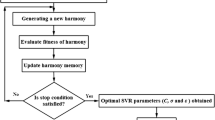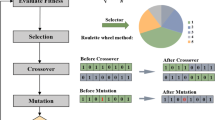Abstract
The uniaxial compressive strength (UCS) and elasticity modulus (E) are two of the most quoted rock strength parameters in engineering application. Due to approved technical difficulties indirect measurements, the tendency for determining these parameters through predictive models using simpler and cheaper tests in practical oriented applications have widely been highlighted. In this paper, a new hybridized multi-objective support vector regression (MSVR) model integrated with the firefly metaheuristic algorithm (FMA) was developed to touch upon a computational method in rock engineering purposes. The optimum internal parameters were adjusted through parametric investigation using 222 physical and mechanical rock properties corresponding to a variety of quarried stones from all over Iran. The accuracy and robustness of models were evaluated using different error indices, the area under curve for receiver operation characteristics (AUCROC) and F1-score criteria. Comparing to MSVR, the predictability level of UCS and E showed 8.35% and 5.47% improvement in hybrid MSVR-FMA. The superior and more promising results imply that hybrid MSVR-FMA as a flexible alternative can be applied for rock strength prediction in designing of construction projects. Using tow sensitivity analyses, the point load index and P-wave velocity were distinguished as the main effective factors on predicted UCS and E.









Similar content being viewed by others
References
Abbaszadeh Shahri A, Gheirati A, Espersson M (2014) Prediction of rock mechanical parameters as a function of P-wave velocity. Int Res J Earth Sci 2(9):7–14
Abbaszadeh Shahri A, Larsson S, Johansson F (2016) Updated relations for the uniaxial compressive strength of marlstones based on P-wave velocity and point load index test. Innov Infrastruct Solut 1:17. https://doi.org/10.1007/s41062-016-0016-9
Abbaszadeh Shahri A (2016) Assessment and prediction of liquefaction potential using different artificial neural network models—a case study. Geotech Geol Eng 34(3):807–815. https://doi.org/10.1007/s10706-016-0004-z
Abbaszadeh Shahri A, Larsson S, Renkel C (2020) Artificial intelligence models to generate visualized bedrock level: a case study in Sweden. Model Earth Syst Environ. https://doi.org/10.1007/s40808-020-00767-0
Abdi Y, Garavand AT, Sahamieh RZ (2018) Prediction of strength parameters of sedimentary rocks using artificial neural networks and regression analysis. Arab J Geosci 11:587. https://doi.org/10.1007/s12517-018-3929-0
Aboutaleb Sh, Behnia M, Bagherpour R, Bluekian B (2018) Using non-destructive tests for estimating uniaxial compressive strength and static Young’s modulus of carbonate rocks via some modeling techniques. Bull Eng Geol Environ 77(4):1717–1728. https://doi.org/10.1007/s10064-017-1043-2
Alemdag S, Gurocak Z, Cevik A, Cabalar AF, Gokceoglu C (2016) Modeling deformation modulus of a stratified sedimentary rock mass using neural network, fuzzy inference and genetic programming. Eng Geol 203:70–82. https://doi.org/10.1016/j.enggeo.2015.12.002
Amiri B, Hossain L, Crawford JW, Wigand RT (2013) Community detection in complex networks: multi-objective enhanced firefly algorithm. Knowl Based Syst 46(1):1–11. https://doi.org/10.1016/j.knosys.2013.01.004
Apostolopoulos T, Vlachos A (2011) Application of the firefly algorithm for solving the economic emissions load dispatch problem. Int J Combin. https://doi.org/10.1155/2011/523806
Arsuaga-Rios M, Vega-Rodriguez MA (2012) Multi-objective firefly algorithm for energy optimization in grid environments. In: Dorigo M et al (eds) Swarm intelligence. ANTS 2012. Lecture notes in computer science, vol 7461. Springer, Berlin. https://doi.org/10.1007/978-3-642-32650-9_41
Asheghi R, Abbaszadeh Shahri A, Khorsand Zak M (2019) Prediction of strength index parameters of different rock types using hybrid multi output intelligence model. Arab J Sci Eng 44(10):8645–8659. https://doi.org/10.1007/s1336-019-04046-8
Asheghi R, Hosseini SA, Sanei M, Abbaszadeh Shahri A (2020) Updating the neural network sediment load models using different sensitivity analysis methods—a regional application. J Hydroinf. https://doi.org/10.2166/hydro.2020.098
Awad M, Khanna R (2015) Support vector regression. In: Efficient learning machines. Apress, Berkeley, pp 67–80. https://doi.org/10.1007/978-1-4302-5990-9_4
Beiki M, Majdi A, Givshad AD (2013) Application of genetic programming to predict the uniaxial compressive strength and elastic modulus of carbonate rocks. Int J Rock Mech Min Sci 63:159–169. https://doi.org/10.1016/j.ijrmms.2013.08.004
Behnia D, Behnia M, Shahriar K, Goshtasbi K (2017) A new predictive model for rock strength parameters utilizing GEP method. Procedia Eng 191:591–599. https://doi.org/10.1016/j.proeng.2017.05.222
Bennett KP, Mangasarian OL (1992) Robust linear programming discrimination of two linearly inseparable sets. Optim Methods Softw 1:23–34. https://doi.org/10.1080/10556789208805504
Chandrasekaran K, Simon SP (2012) Network and reliability constrained unit commitment problem using binary real coded firefly algorithm. Int J Electr Power Energy Syst 42(1):921–932. https://doi.org/10.1016/j.ijepes.2012.06.004
Chang CC, Lin CJ (2011) LIBSVM: a library for support vector machines. ACM Trans Intell Syst Technol. https://doi.org/10.1145/1961189.1961199
Cherkassky V, Mulier F (1998) Learning from data: concepts, theory and methods. Wiley, New York
Coelho LDS, Mariani VC (2013) Improved firefly algorithm approach applied to chiller loading for energy conservation. Energy Build 59:273–278. https://doi.org/10.1016/j.enbuild.2012.11.030
Coelho LS, de Andrade Bernert DL, Mariani VC (2011) A chaotic firefly algorithm applied to reliability-redundancy optimization. In: 2011 IEEE Congress of Evolutionary Computation (CEC’11), 12117561, New Orleans, USA, pp 517–521. https://doi.org/10.1109/CEC.2011.5949662
Coelho LS, Mariani VC (2012) Firefly algorithm approach based on chaotic Tinkerbell map applied to multivariable PID controller tuning. Comput Math Appl 64(8):2371–2382. https://doi.org/10.1016/j.camwa.2012.05.007
Courant R, Hilbert D (1953) Methods of mathematical physics. Interscience, New York
Drucker H, Burges CJC, Kaufman L, Smola AJ, Vapnik VN (1997) Support vector regression machines. In: proceedings of NIPS'96, the 9th international conference on neural information processing systems, pp 155–161
Gao ML, Li LL, Sun XM, Yin LJ, Li HT, Luo DS (2015) Firefly algorithm based particle filter method for visual tracking. Optik 126:1705–1711
Gevrey M, Dimopoulos I, Lek S (2003) Review and comparison of methods to study the contribution of variables in artificial neural network models. Ecol Model 160(3):249–264. https://doi.org/10.1016/S0304-3800(02)00257-0
Ghaderi A, Abbaszadeh Shahri A, Larsson S (2019) An artificial neural network based model to predict spatial soil type distribution using piezocone penetration test data (CPTu). Bull Eng Geol Environ 78:4579–4588. https://doi.org/10.1007/s10064-018-1400-9
Hand D, Christen P (2018) A note on using the F-measure for evaluating record linkage algorithms. Stat Comput 28(3):539–547. https://doi.org/10.1007/s11222-017-9746-6
Imbens GW, Lemieux T (2008) Regression discontinuity designs: a guide to practice. J Econ 142(2):615–635
ISRM (1981) Rock characterization testing and monitoring. In: Brown ET (ed) ISRM suggested methods, International Society of Rock Mechanics. Pergamon Press, Oxford
Jahed Armaghani D, Mohamad ET, Momeni E, Monjezi M, Narayanasamy MS (2016) Prediction of the strength and elasticity modulus of granite through an expert artificial neural network. Arab J Geosci 9:48. https://doi.org/10.1007/s12517-015-2057-3
Kavousi-Fard A, Samet H, Marzbani F (2014) A new hybrid modified firefly algorithm and support vector regression model for accurate short term load forecasting. Expert Syst Appl 41(13):6047–6056
Li X, Chen X, Yan Y, Wei W, Wang J (2014) Classification of EEG signals using a multiple kernel learning support vector machine. Sensors 14(7):12784–12802. https://doi.org/10.3390/s140712784
Li HM, Ye CM (2012) Firefly algorithm on multi-objective optimization of production scheduling system. Adv Mech Eng Appl 3(1):258–262
Madhubabu N, Singh PK, Kainthola A, Mahanta B, Tripathy A, Singh TN (2016) Prediction of compressive strength and elastic modulus of carbonate rocks. Measurement 88:202–213. https://doi.org/10.1016/j.measurement.2016.03.050
Mahdiabadi N, Khanlari G (2019) Prediction of uniaxial compressive strength and modulus of elasticity in calcareous mudstones using neural networks, fuzzy systems, and regression analysis. Period Polytech Civil Eng 63(1):104–114. https://doi.org/10.3311/PPci.13035
Marichelvam MK, Prabaharan T, Yang XS (2013) A discrete firefly algorithm for the multi-objective hybrid flowshop scheduling problems. IEEE Trans Evol Comput 18(2):301–305. https://doi.org/10.1109/TEVC.2013.2240304
Matin SS, Farahzadi L, Makaremi S, Chelgani SC, Sattari GH (2018) Variable selection and prediction of uniaxial compressive strength and modulus of elasticity by random forest. Appl Soft ing 70:980–987. https://doi.org/10.1016/j.asoc.2017.06.030
Min J, Lee Y (2005) Bankruptcy prediction using support vector machine with optimal choice of kernel function parameters. Expert Syst Appl 28(4):603–614. https://doi.org/10.1016/j.eswa.2004.12.008
Jiang M, Hu W, Qiu L, Shi M, Tan KC (2018) Solving dynamic multi-objective optimization problems via support vector machine. In: 2018 tenth international conference on advanced computational intelligence (ICACI). https://doi.org/10.1109/ICACI.2018.8377567
Momeni E, Jahed Armaghani D, Hajihassani M, For M, Amin M (2015) Prediction of uniaxial compressive strength of rock samples using hybrid particle swarm optimization-based artificial neural networks. Measurement 60:50–63. https://doi.org/10.1016/j.measurement.2014.09.075
Moradian ZA, Behnia M (2009) Predicting the uniaxial compressive strength and static Young’s modulus of intact sedimentary rocks using the ultrasonic test. Int J Geomech 9(1):14–19. https://doi.org/10.1061/(ASCE)1532-3641(2009)9:1(14)
Najibi AR, Ghafoori M, Lashkaripour GR, Asef MR (2015) Empirical relations between strength and static and dynamic elastic properties of Asmari and Sarvak limestones, two main oil reservoirs of Iran. J Petol Sci Eng 126:78–82. https://doi.org/10.1016/j.petrol.2014.12.010
Nocedal J, Wright SJ (1999) Numerical optimization. Springer-Verlag, New York
Palchik V (2011) On the ratios between elastic modulus and uniaxial compressive strength of heterogeneous carbonate rocks. Rock Mech Rock Eng 44(1):121–128. https://doi.org/10.1007/s00603-010-0112-7
Pedhazur EJ (1997) Multiple regression in behavioral research, 3rd edn. Harcourt Brace College Publishers, Fort Worth
Pérez-Cruz F, Navia-Vázquez A, Alarcón-Diana PL, ArtésRodríguez A (2000a) An IRWLS procedure for SVR. In: Proc. EUSIPCO, Tampere, Finland
Pérez-Cruz F, Alarcón-Diana PF, Navia-Vázquez A, ArtésRodríguez A (2000) Fast training of support vector classifiers. In: Leen T, Dietterich T, Tresp V (eds) Neural information processing systems, vol 13. MIT Press, Cambridge, pp 734–740
Platt J (1999) Fast training of support vector machines using sequential minimal optimization, advances in Kernel methods support vector learning. MIT Press, Cambridge
Powers DA, Xie Y (2008) Statistical methods for categorical data analysis, 2nd edn. Emerald, Howard House
Rampriya B, Mahadevan K, Kannan S (2010) Unit commitment in deregulated power system using Lagrangian firefly algorithm. IEEE Int Conf Commun Control Comput Technol (ICCCCT2010) 11745352 Ramanathapuram India. https://doi.org/10.1109/ICCCCT.2010.5670583
Sayadi MK, Ramezanian R, Ghaffari-Nasab N (2010) A discrete firefly meta-heuristic with local search for makespan minimization in permutation flow shop scheduling problems. Int J Ind Eng Comput 1(1):1–10. https://doi.org/10.5267/j.ijiec.2010.01.001
Singh R, Rk U, Ahmad M, Ansari MK, Sharma LK, Singh TN (2017) Prediction of geomechanical parameters using soft computing and multiple regression approach. Measurement 99:108–119. https://doi.org/10.1016/j.measurement.2016.12.023
Stehman SV (1997) Selecting and interpreting measures of thematic classification accuracy. Remote Sens Environ 62(1):77–89. https://doi.org/10.1016/S0034-4257(97)00083-7
Suttorp T, Igel C (2006) Multi-objective optimization of support vector machines. In: Jin Y (eds) Multi-objective machine learning. Studies in computational intelligence, vol 16. Springer, Berlin, pp 199–220. https://doi.org/10.1007/3-540-33019-4_9
Tuia D, Verrelst J, Alonso L, Pérez-Cruz F, Camps-Valls G (2011) Multi output support vector regression for remote sensing biophysical parameter estimation. IEEE Geosci Remote Sens Lett 8(4):804–808. https://doi.org/10.1109/LGRS.2011.2109934
Umrao RK, Sharma LK, Singh R, Singh TN (2018) Determination of strength and modulus of elasticity of heterogenous sedimentary rocks: an ANFIS predictive technique. Measurement 126:194–201. https://doi.org/10.1016/j.measurement.2018.05.064
Vapnik VN (1995) The nature of statistical learning theory, 2nd edn. Springer-Verlag, New York
Wang H, Hu D (2005) Comparison of SVM and LS-SVM for regression. In: Proc. Int. Conf. on neural networks and brain. IEEE, New York, pp 279–283. https://doi.org/10.1109/ICNNB.2005.1614615
Willmott CJ (1984) On the evaluation of model performance in physical geography. Spatial Stat Models. https://doi.org/10.1007/978-94-017-3048-8_23
Yang XS (2008) Firefly algorithm. Luniver Press, Bristol
Yang XS (2012) Chaos-enhanced firefly algorithm with automatic parameter tuning. Int J Swarm Intell Res 2(4):125–136. https://doi.org/10.4018/jsir.2011100101
Yang XS (2013) Multi-objective firefly algorithm for continuous optimization. Eng Comput 29(2):175–184
Yang XS (2014) Nature-inspired optimization algorithms. Elsevier. https://doi.org/10.1016/C2013-0-01368-0
Yun Y, Yoon M, Nakayama H (2009) Multi-objective optimization based on meta-modeling by using support vector regression. Optim Eng 10:167–181. https://doi.org/10.1007/s11081-008-9063-1
Yun Y, Nakayama H, Arakawa M (2004) Using support vector machines in multi-objective optimization. In: 2004 IEEE international joint conference on neural networks (IEEE Cat. No. 04CH37541). https://doi.org/10.1109/IJCNN.2004.1379903
Author information
Authors and Affiliations
Corresponding author
Rights and permissions
About this article
Cite this article
Abbaszadeh Shahri, A., Maghsoudi Moud, F. & Mirfallah Lialestani, S. A hybrid computing model to predict rock strength index properties using support vector regression. Engineering with Computers 38, 579–594 (2022). https://doi.org/10.1007/s00366-020-01078-9
Received:
Accepted:
Published:
Issue Date:
DOI: https://doi.org/10.1007/s00366-020-01078-9




